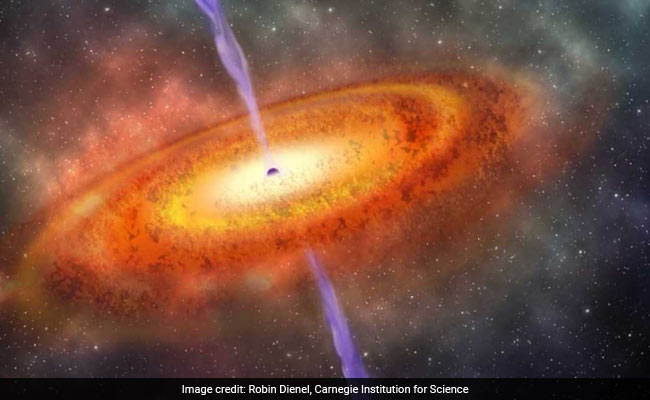Eduardo Banados had three evenings to spot something that won’t not, in any case, exist: a supermassive dark opening near the get-go.
At the Las Campanas Observatory in Chile, roosted high on a mountain on the planet’s driest betray, he checked for the mark of a gigantic, undetectable sinkhole in the sky slurping up a whirlpool of splendid, hot issue.
Just before dawn on the third night, he discovered it. Way out at the very edge of the detectable universe, there lingered a dark opening 800 million times more enormous than the sun. The flag had voyage more than 13 billion light-years crosswise over time and space to achieve Banados’ telescope.
In a paper distributed in the diary Nature Wednesday, Banados and his partners report that their new find is the most established and the most removed dark gap at any point found.
The protest’s size is dazzling, Banados stated, in light of the fact that it existed only 690 million years after the Big Bang, when the universe was only 5 percent of its present age and as yet rising up out of a baffling time known as “the Dark Ages.”
That such a vast dark opening can exist so right on time fit as a fiddle models of how dark gaps frame. What’s more, it will offer knowledge into the universe’s difficult to think about early years.
“In the event that the universe was a 50-year-old individual,” Banados clarified. “Presently we have a photo of that individual as a little child . . . when they were more than two.”
The Dark Ages started only a couple of hundred thousand years after the Big Bang, once the hot molecule slurry that constituted the early universe dense into particles. The universe was getting greater and colder in this period, topping off with a featureless mist of hydrogen gas. There were no cosmic systems, stars or supernovas (which show up when stars detonate) – nothing that emitted light. The main type of radiation was an exceptionally powerless hydrogen gleam.
This situation went on for countless years. However at some point amid this uncertain period, the universe as we probably are aware it rose. Gravity manoeuvred hydrogen into the primary gas mists, from which the principal stars were conceived. The radiation from the recently shaped articles broke hydrogen iotas separated into their constituent particles – protons and electrons – at last dissipating the cold mist.
This procedure, called “reionization” in light of the fact that already nonpartisan hydrogen molecules moved toward becoming particles with an electric charge, was the last real change in the universe’s history. Understanding the reionization age, Banados stated, is one of the “boondocks of astronomy.”
The nonattendance of light sources amid the Dark Ages makes it hard to test this period with telescopes. The hydrogen haze additionally entangles matters. Banados says it is as if somebody experienced the universe’s adolescence photograph collection and tore out every one of the photos of its most developmental years.
However, contemplating the conduct of the universe’s first quasars – glowing whirlpools of quick moving, ultrahot particles encompassing supermassive dark openings at the focuses of systems – could reveal some insight into this equivocal time.
That expectation is the thing that drove Banados, a stargazer at the Carnegie Observatories in California, to the Chilean peak in March. It was not by any stretch of the imagination clear whether he’d have the capacity to discover a quasar so far away. Supermassive dark openings gobble up enormous measures of the issue, pressing the proportional mass of a few hundred thousand suns into a space so little that gravity wraps around it like an imperceptibility shroud and makes it vanish. A question like that needs quite a while to develop and more issue that might have been accessible in the youthful universe.
In any case, the question Banados and his associates found, called ULAS J1342+0928, was much greater than they’d expected – recommending that something may have influenced dark gaps to develop all the more rapidly. Researchers don’t yet know the fundamental purposes behind such fast development, or whether still more established dark gaps are holding up to be found.
“This is the thing that we are attempting to push forward,” Bandos said. “Eventually these shouldn’t exist. At the point when is that point? Regardless we don’t have the foggiest idea.”
In a friend paper distributed in the Astrophysical Journal Letters, the researchers report another odd finding: The cosmic system where ULAS J1342+0928 abides was producing new stars “like insane,” Bandos said. Items the measure of our sun were rising 100 times as much of the time as they do in our own particular cosmic system today.
“To manufacture stars you require tidy,” Bandos said. “In any case, it’s extremely difficult to shape this clean in such brief period on enormous scales – that requires a few ages of supernovae to detonate.”
Amid the universe’s baby years, there hadn’t been the ideal opportunity for a few rounds of stars living and passing on. So where were the elements for all these new stars originating from?
Perceptions of the light originating from the quasar point to a third interest: This protest lived when generally a large portion of the universe’s hydrogen was as yet nonpartisan. That spots it right smack touch amidst the reionization age when the light of the primary heavenly questions consumed with smouldering heat the Dark Ages haze.
“Perhaps we are testing the area now where the principal stars and universes shaped,” Bandos said. The quasar “is essentially a gold dig for follow-up investigations of this 2 1/2-year-old universe.”




























